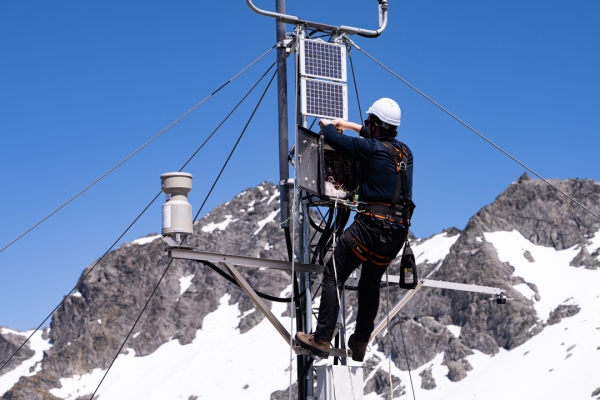On a still and sunny summer day when most Kiwis were looking longingly towards the beach, two NIWA staff had their eyes firmly on the Southern Alps.
Adrian Aarsen and James Townshend jumped on board a helicopter in Queenstown to complete a last-minute piece of work during the Christmas break – servicing NIWA’s Mt. Larkins snow and ice monitoring station.
The snow and ice network
The Mt. Larkins station, is part of a network of 11 NIWA snow and ice stations. The stations are used to generate a valuable long-term record of alpine weather and snow measurements.
NIWA hydrologist Dr Christian Zammit, who manages the snow and ice monitoring programme, says the network was set up for three main reasons: to measure how much water is stored as snow, to detect climate change impacts, and to better understand cryospheric processes in the New Zealand alpine environment.
The network began operating in 2008. By 2013, all 11 stations had been set up, representing a range of high-altitude areas of the country between 800 and 2200 metres above sea-level including Aoraki-Mt. Cook, Mt. Aspiring, Arthur’s Pass, Tongariro and Fiordland.
Weather conditions are measured at all stations. Snow depth, density and temperature are measured at six stations. At the remaining stations just depth of snow is measured.

Environmental Monitoring Technician James Townshend works on the station’s computer logger. [Photo: Sam Fraser-Baxter, NIWA]
Dr Zammit says snow is a valuable economic resource for New Zealand, so understanding the amount, seasonal nature and long-term changes to snow and ice is hugely important – especially in a warming climate.
Snow melt contributes as much as 30% of the water that flows into the main South Island hydro-electricity lakes. Large areas of the South Island rely directly on water from snow melt for irrigation, and the ski industry cannot exist without snow. In 2019 alone, there were 1.7 million visits to ski fields in New Zealand.
Dr Zammit says climate change will impact both the amount and seasonality of snowfall in New Zealand.
“We expect snowlines to shift to higher altitudes and there is an expectation that there will be less snow. However, with climate change, extremes get more extreme. So, we may have fewer snow days, but larger amounts of snow falling during storm events.”
Dr Zammit says that because the network has only been operating for seven years, a longer data set will be needed before researchers can confidently say how climate change is impacting our snow and ice, though NIWA’s end of summer snowline survey has documented a long-term decrease in glacier coverage on the Southern Alps over the last 43 years.
Dr Zammit says several organisations use real-time data from the network. The Avalanche forecasting service generated by Mountain Safety Council is one of them.
“Data from the network is the only real time information they have to predict the state of the snowpack, both in and outside of the ski domain. Their daily avalanche risk forecasts are based on this information, their knowledge of the domain and access to weather forecast information.”
Hydro-electricity generators use data from the snow and ice network to estimate the volume and seasonality of snow and ice melt flowing down rivers. The information informs decision-making about when to generate electricity, as well as how electricity is stored and transported.
Atop Mt Larkins – 1915 m above sea level
NIWA field researchers visit each snow and ice station twice a year.
Dr Zammit describes 2020’s snow season as being warm with little snowfall until a few big dumps of snow late in the snow season.
For safety reasons, the stations are only visited on calm, sunny days. Mr. Aarsen says they waited a month for good weather to visit the Mt. Larkins station.
After a 15-minute flight, the researchers have three hours to complete the work needed before the helicopter returns to collect them.
The purpose of the visit is to replace fuel and antifreeze, collect snow samples, empty the snow collector that measures snow fall and make sure the equipment is recording accurate data.
Mr Aarsen says that, despite the sturdy design and build of the stations, lightning, extreme weather and destructive kea means the technicians also have to fix any issues that might have developed since the last visit – in this case some damage caused by a snow storm.
“You're putting in these instruments and you're thinking 'man, I hope this equipment will survive the elements'. The intensity of what the stations withstand is amazing.
“Kea will come and pick at anything they can. Especially the wind sensors, they love picking them apart. We’ve had a lot of equipment ruined by kea, once they get into something, they get into it pretty hard.”
While the researchers worked in t-shirts in December, Mr Aarsen says working in minus zero conditions during winter is a different story.
“The cold and snow make everything harder. It makes moving around or trying to undo screws really tricky when it's freezing and you're wearing a lot of layers. There can be up to a metre and a half of snow at Larkins.”
As a safety precaution, the researchers bring up a survival bag that contains a tent, gas-cooker, food, sleeping bags and extra layers if a freak shift in the weather meant a helicopter couldn’t safely collect the workers.

